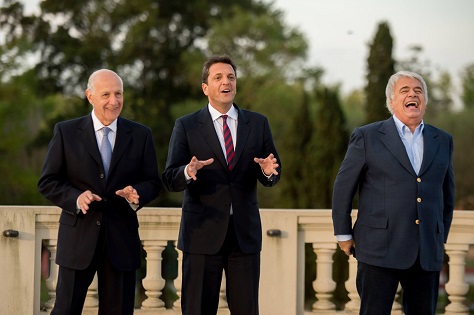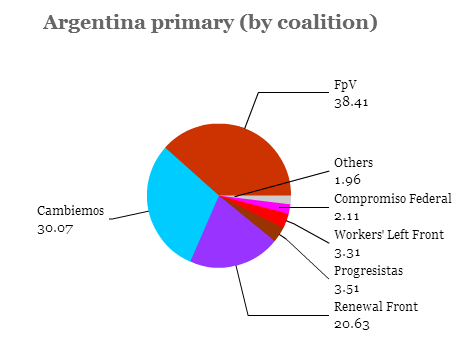
A surprisingly tighter race than expected for Argentina’s presidency is making it more likely that frontrunner Daniel Scioli will win outright in the first round on Sunday, October 25.![]()
Back in August, Scioli, the outgoing governor of Buenos Aires province and the presidential nominee of outgoing president Cristina Fernández de Kirchner and the governing Frente para la Victoria (FpV, the Front for Victory), demonstrated his strength by winning around 38.5% of the vote in Argentina’s somewhat unique ‘open primary’ contest.
His nearest contender was Mauricio Macri, the more conservative and economically liberal outgoing mayor of Buenos Aires, who is leading a broad center-right coalition called Cambiemos (which loosely translates as “Let’s change”), which won about 30% of the vote (including the other challengers who competed with Macri for the coalition’s presidential nomination).
Far back in third place was Sergio Massa, one of Kircher’s first cabinet chiefs, now the mayor of Tigre and the leader of an alternative peronista group, the Frente Renovador (FR, Renewal Front), which won just 20.5% of the vote.
* * * * *
RELATED: Kirchner 2019 comeback could
complicate Scioli presidential bid
RELATED: Scioli leads in Argentine presidential race after primaries
* * * * *
A one-time frontrunner after leading his new group to the top result in Buenos Aires province during the 2013 midterm elections, Massa’s appeal seems to have stalled through 2014 and earlier in 2015. His electoral alliance choices turned out to be weaker than expected, and he lacks the voter base that both Scioli (as leader of Argentina’s most populous province) and Macri (as leader of Argentina’s capital city) can boast. Moreover, as Kirchner’s approval ratings improved over the course of 2015, so did Scioli’s standing, as he won back disaffected peronistas who might otherwise be tempted to join Massa’s alternative group.
Since August, Scioli continues to lead the pack, while the movement in the race has come in the battle for second place — most polls are now showing that Macri is losing votes and that Massa is gaining. There are many potential reasons.
Explaining the Massa popularity surge
It could be that Argentines feel that Macri is still too close, ideologically speaking, to the economic neoliberalism of the 1990s that many voters feel was responsible for destroying the economy in 1999-2001.
It could be that Macri has been tarred by association with Fernando Niembro, a businessman who had been one of the coalition’s leading congressional candidates from Buenos Aires until suspending his campaign in September following an indictment on money laundering charges. That connection has made it hard to argue that Macri will make doing business in Argentina more efficient, transparent or graft-free.
It could be that Macri has done so much to signal that he will not introduce radical change that voters are doubting his authenticity, ability or resolve. He’s already pledged not to re-privatize the Argentine state oil company, YPF, or the airline company Aerolíneas Argentinas. If there’s one thing that Macri is not, it’s a peronista. But he has spent much of the post-primary period embracing peronismo. Earlier this month, Macri even unveiled a new statue of Juan Perón in the capital, awkwardly arguing that he shared the values of peronismo:
“I am not a Peronist but I have social justice in my heart,” Macri said as he unveiled the statue of Peron last week. “I want to invite all Peronists to work with us to create the Argentina we all dream about.”
But Massa’s improvements could also come from a belief that Massa represents a better chance for gradual ‘change,’ with a better shot of defeating Scioli if the race continues to a runoff on November 22. There are still real doubts about Scioli’s ability to run an independent administration with so many Kirchner loyalists in key positions, including the vice presidency.
As a credible peronista (unlike Macri) and a former kirchnerista, Massa would probably have an easier time governing alongside an Argentine congress still dominated by Kirchner’s supporters and other peronistas. Macri has announced that Roberto Lavagna, Argentina’s well-regarded finance minister between 2002 and 2005, and a 2007 presidential candidate himself, would return to the finance ministry in a Massa administration. José Manuel de la Sota, a longtime figure in peronista politics, is currently serving his third term as governor of Córdoba province, to the northwest of Buenos Aires province and the second-most populous province in the country. He would take on the role of cabinet chief in the Massa presidency.
Whatever the reason, it’s meant that the gap between Massa and Macri is narrowing as election day arrives, at least according to the polling data available.
Why Scioli could benefit from a tighter race among the runners-up
As the two candidates seem to converge, though, it has the ironic effect of making Scioli’s immediate victory on Sunday much more likely.
Under the rules of Sunday’s contest however, Scioli can win an outright first-round victory in two ways:
- First, he would have to win 45% of the vote. (Polls show that Scioli is hovering between 36% and 42% of the vote, so this seems unlikely).
- Second, he would have to win at least 40% of the vote, with a winning margin of more than 10% against the nearest candidate.
These rules have driven some of the most important tactical decisions of the campaign.
For example, Macri shied away from pushing Massa into a coalition (an outcome that seemed likelier in July when Massa’s support was at its nadir). That’s because Macri knows he will never defeat Scioli by a margin of more than 55% to 45%. If Macri, however, believes he could defeat Scioli by a narrower 51% to 49% margin, he needs to engineer a runoff vote in order to win the presidency. Eliminating Massa prior to the first round (and therefore, making the first round a de facto runoff with Scioli) does Macri no good, because the threshold for Scioli in the first round is just 45%, not an absolute majority.
But the rules also mean that as the contest for second place becomes more competitive, Scioli has an easier chance of a first-round victory.
By way of thought experiment, suppose that Scioli can depend on 40% support, the opposition can depend on 50% support on Sunday (with another 10% committed to the three presidential campaigns of smaller parties). If pro-opposition voters divide equally between Macri and Massa, Scioli will win easily in the first round (40% to 25% to 25%).
Contrast that another scenario that’s more in line with the result of the August primary. Suppose that Scioli still has 40%, but Macri has 32% and Massa has just 18%. In this scenario, Macri would just as easily advance to the November runoff (where, of course, he need not limit Scioli to under 45%, but to under 50.01%).
Or contrast it with yet another scenario that is becoming increasingly likely. Massa, riding a wave of growing support, narrowly defeats Macri on Sunday by, say, a margin of 26% to 24%. It would be a clear shift in momentum, signalling a Massa boom that might well otherwise have a very good chance at winning the runoff.
It doesn’t matter. Scioli would still win the presidency in the first round.
Make no mistake, this is game theory at its finest, and these convoluted rules are an easy way for incumbents and governing parties to stay in power, even when they don’t command the support of a full majority of voters.
If Massa actually pulls ahead of Macri in Sunday’s election, but not by a sufficient margin to advance to a one-on-one runoff against Scioli, there are going to be a lot of questions about the underlying fairness of Argentina’s electoral system.

Excellent, well-balanced, thoughtful.